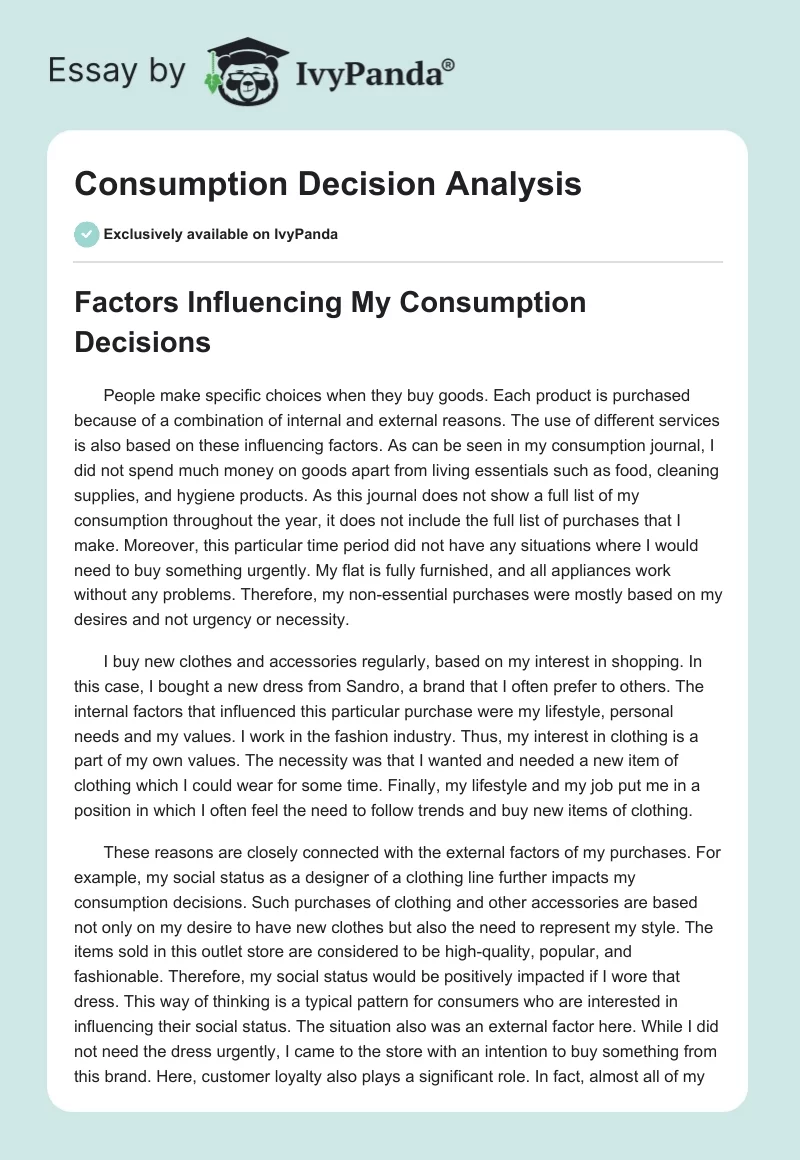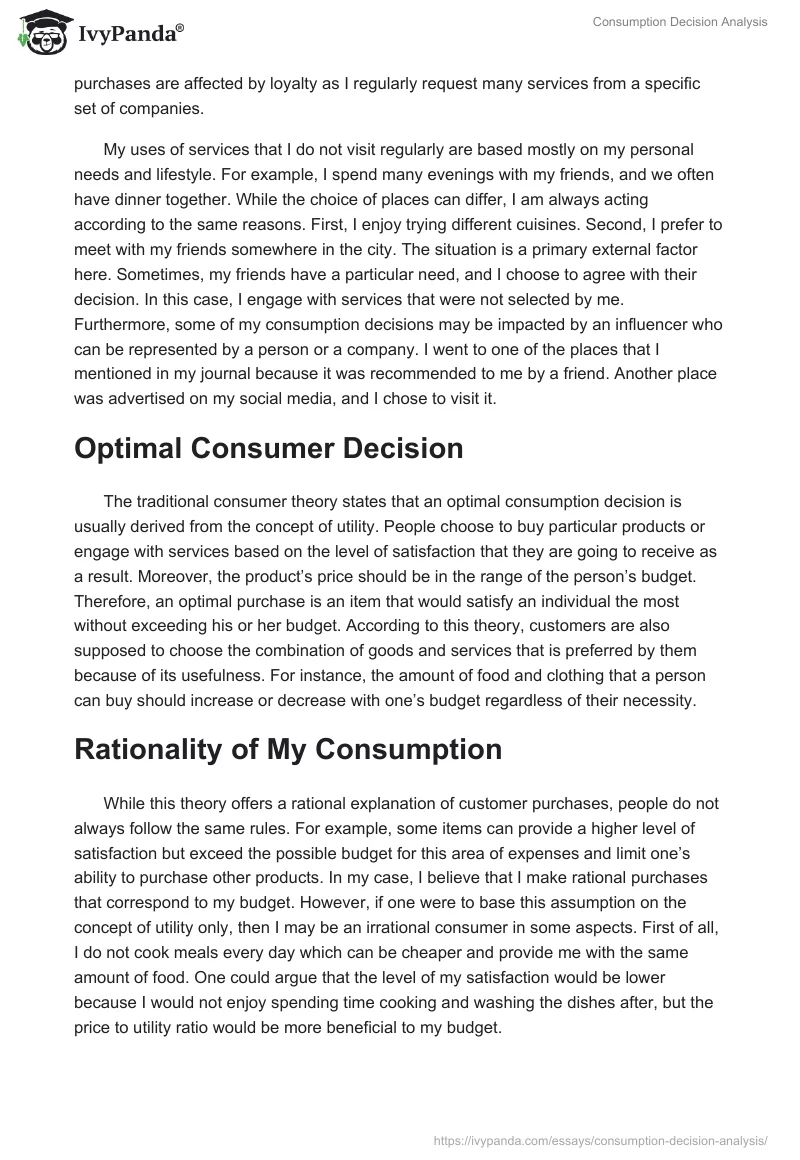Factors Influencing My Consumption Decisions
People make specific choices when they buy goods. Each product is purchased because of a combination of internal and external reasons. The use of different services is also based on these influencing factors. As can be seen in my consumption journal, I did not spend much money on goods apart from living essentials such as food, cleaning supplies, and hygiene products. As this journal does not show a full list of my consumption throughout the year, it does not include the full list of purchases that I make. Moreover, this particular time period did not have any situations where I would need to buy something urgently. My flat is fully furnished, and all appliances work without any problems. Therefore, my non-essential purchases were mostly based on my desires and not urgency or necessity.
I buy new clothes and accessories regularly, based on my interest in shopping. In this case, I bought a new dress from Sandro, a brand that I often prefer to others. The internal factors that influenced this particular purchase were my lifestyle, personal needs and my values. I work in the fashion industry. Thus, my interest in clothing is a part of my own values. The necessity was that I wanted and needed a new item of clothing which I could wear for some time. Finally, my lifestyle and my job put me in a position in which I often feel the need to follow trends and buy new items of clothing.
These reasons are closely connected with the external factors of my purchases. For example, my social status as a designer of a clothing line further impacts my consumption decisions. Such purchases of clothing and other accessories are based not only on my desire to have new clothes but also the need to represent my style. The items sold in this outlet store are considered to be high-quality, popular, and fashionable. Therefore, my social status would be positively impacted if I wore that dress. This way of thinking is a typical pattern for consumers who are interested in influencing their social status. The situation also was an external factor here. While I did not need the dress urgently, I came to the store with an intention to buy something from this brand. Here, customer loyalty also plays a significant role. In fact, almost all of my purchases are affected by loyalty as I regularly request many services from a specific set of companies.
My uses of services that I do not visit regularly are based mostly on my personal needs and lifestyle. For example, I spend many evenings with my friends, and we often have dinner together. While the choice of places can differ, I am always acting according to the same reasons. First, I enjoy trying different cuisines. Second, I prefer to meet with my friends somewhere in the city. The situation is a primary external factor here. Sometimes, my friends have a particular need, and I choose to agree with their decision. In this case, I engage with services that were not selected by me. Furthermore, some of my consumption decisions may be impacted by an influencer who can be represented by a person or a company. I went to one of the places that I mentioned in my journal because it was recommended to me by a friend. Another place was advertised on my social media, and I chose to visit it.
Optimal Consumer Decision
The traditional consumer theory states that an optimal consumption decision is usually derived from the concept of utility. People choose to buy particular products or engage with services based on the level of satisfaction that they are going to receive as a result. Moreover, the product’s price should be in the range of the person’s budget. Therefore, an optimal purchase is an item that would satisfy an individual the most without exceeding his or her budget. According to this theory, customers are also supposed to choose the combination of goods and services that is preferred by them because of its usefulness. For instance, the amount of food and clothing that a person can buy should increase or decrease with one’s budget regardless of their necessity.
Rationality of My Consumption
While this theory offers a rational explanation of customer purchases, people do not always follow the same rules. For example, some items can provide a higher level of satisfaction but exceed the possible budget for this area of expenses and limit one’s ability to purchase other products. In my case, I believe that I make rational purchases that correspond to my budget. However, if one were to base this assumption on the concept of utility only, then I may be an irrational consumer in some aspects. First of all, I do not cook meals every day which can be cheaper and provide me with the same amount of food. One could argue that the level of my satisfaction would be lower because I would not enjoy spending time cooking and washing the dishes after, but the price to utility ratio would be more beneficial to my budget.
Furthermore, my use of salon treatments could also be substituted with cheaper alternatives that would require me to perform most of the activities at how. The same can be said about my physical activity. Nevertheless, these consumption decisions seem the most rational to me because of my schedule and financial possibilities. I work and study. Therefore, my time is limited and should be scheduled with care. The services that I use offer a high-quality result that I am satisfied with more than I would be with cheaper alternatives. Moreover, my budget, which comes from my income, parents’ help, savings, and other occasional sources, allows me to make such decisions. I do not feel strained by making these decisions, and I do not think that I could choose something even more appealing than the options I utilize currently. Therefore, my purchases are rational according to the traditional theory.
The use of a car in the city is also rational as it allows me to save time and plan my day efficiently. While using public transportation, for instance, could be cheaper, it would not offer me the same feeling of security or provide me with the same amount of free time. Moreover, the versatility of a car adds to the level of satisfaction for me because I can use it to drive my friends, family members and various products and goods. Therefore, parking, gasoline and other car-related expenses are reasonable.
Why Consumers Behave Differently
Many reasons can explain the differences between the theory and the actual decisions of people. First of all, the internal and external factors mentioned above can significantly influence one’s choice of products and services. For example, an influencer who can convince people to purchase something that can exceed their budget. One’s need to adhere to a particular social status, which makes him or her spend more money on clothes than on food. Alternatively, one’s temporary strained financial situation which makes them purchase something that does not meet their usual level of satisfaction. People who make spontaneous purchases because of various influences can buy something that does not correspond to their regular consumption habits.
This theory does not account for some other parts of the budget as well. For example, a person may choose to purchase a product that is satisfying enough but is much cheaper than what this person could afford. The traditional concept of optimal consumer choice argues that people always choose the item that offers the maximum amount of satisfaction for the highest possible price. Moreover, it specifies that people prefer to buy more of the same product if it is provided at the same cost. However, some people restrain themselves for various reasons that are not connected to spending. Health concerns, dietary restrictions or brand loyalty can be a reason for a person to choose a product that does not offer the highest level of satisfaction. Urgency also often affects one’s purchasing decisions as it does not allow one to assess the quality and usability of the presented choices. In this case, people can be more interested in buying a product than in choosing it.
Savings for the future can also impact customers’ decisions. While some people may afford more expensive and more satisfactory options, they can choose to purchase cheaper alternatives to save money for something else. Distant goals and opportunities can become a reason for deliberate financial constraints. As a contrast, people can make impulsive purchases which can make them change their buying habits for some time. Here, people’s priorities can be influenced by other factors that affect them only for a short amount of time. This effect can come from one’s personality traits such as impatience and indecisiveness. Moreover, this pattern of behaviour can also be a result of insufficient research. The traditional theory suggests that people are always aware of which products are the best in their category. However, it is rarely true.


